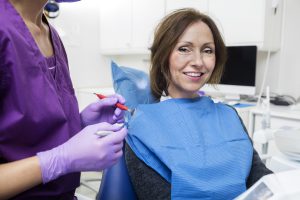
Have you ever been uncertain when providing dental clearance for crucial treatments, such as heart surgery or joint replacement? In my practice, we look at the clinical signs and symptoms for oral disease, but we additionally observe the patient’s oral health at the molecular level. Let me share a case with you that illustrates the importance of salivary testing and its profound impact on the credibility of clearing a patient for surgery.
A long-standing patient presented to my office on July 22, 2010 indicating the need for dental clearance prior to cardiac surgery. She is 63 years old, partially edentulous, restored with upper and lower removable partial dentures. She was previously made aware of the presence of periodontal disease but did not present for evaluation and treatment planning.
Esther stated that she is going to have cardiac surgery, specifically involving replacement of the mitral valve and repair of the aortic valve, both of which will be completed during one procedure. Prior to the surgery the cardiologist needed documentation stating that there are no identifiable sources of active infection in the oral cavity.
This is not an unusual request of dental providers prior to a variety of surgeries. Periodontal evaluation revealed case type 4 periodontal disease in the upper right, upper left and lower left quadrants. Tooth #14 was missing and #16 was tilted mesially, creating a biofilm and food trap. Additionally, the partial denture framework and clasps increased biofilm accumulation. The perio diagnosis and case typing indicated the disease severity, but does not shed any light on the cause of the disease, namely, the specific periodontal pathogens responsible for this clinical presentation. Salivary diagnostic bacterial DNA testing was performed, utilizing OralDNA® Labs, MyPerioPath® test. The test results revealed the presence of high levels of 6 pathogens including 3 high risk pathogens; P. gingivalis, T. forsythia and T. denticola.
The number and virulence of the causative bacteria presented a significant treatment challenge. Esther was given a copy of the DNA test results, along with a letter to her cardiologist, with whom she had an appointment the following day. Several days later the cardiologist called to discuss the results of the DNA test and its significance for our mutual patient. The large number of pathogens and the inclusion of 3 highly virulent species of bacteria were pointed out. I indicated that the only way I could qualitatively and quantitatively determine bacteria level reduction was to provide periodontal treatment and re-test the bacterial levels, a process which would take approximately 7 weeks. Esther’s cardiologist said the open heart surgery could wait that period of time and he would not proceed until the oral infection and high bacterial counts were controlled. He indicated that periodontal surgery was not to be undertaken. He concluded the call by stating that he would schedule the surgery when dental clearance was provided.
Non-surgical periodontal therapy was provided in one visit. Treatment consisted of scaling and root planing, subgingival irrigation with 10% povidone iodine, placement of locally applied antibiotics, (Arestin®, Minocycline hydrochloride microspheres 1mg) in all perio pockets and prescription antibiotics; Amoxicillin 500 mg, 3x/day for 8 days and Metronidazole 500 mg, 2x/day for eight days.
The patient was given extensive home care instructions. The Philips Sonicare FlexCare toothbrush was recommended along with a variety of interdental brushes, floss, tongue cleaner and Listerine® mouthwash, all with the intention of maximizing biofilm control on a daily basis. Sufficient instructions were provided for Esther to demonstrate proficiency with each of the home care items. The patient’s home care up to that point was less than ideal. Esther understood the consequences of achieving less than ideal perio treatment and biofilm control results on her heart surgery, namely the increased risk of post-op complications.
Re-evaluation 4 weeks following perio treatment revealed significant clinical improvement with a reduction in all clinical parameters. Bacterial DNA was re-tested 5 weeks later utilizing the same OralDNA Labs® test. The post-op test results revealed a significant reduction in 5 of the 6 perio pathogens to low levels. Only T. forsythia remained slightly above threshold. The reduction of approximately 85% of the bacterial species, combined with the considerable clinical improvement and home care efficacy were sufficient to recommend proceeding with the heart surgery.
As a clinician, charged with the responsibility of certifying the oral condition of a patient undergoing open heart surgery, having a written, quantifiable DNA analysis of the bacterial levels in the patient’s mouth was critically important. Without the bacterial tests, certifying Esther’s dental clearance for surgery would have been an educated guess at best.
GP Perio column, Jan. 2011
For more information on how to become an OralDNA Provider – scan HERE: 
- The Insights Provided by Salivary Testing - December 27, 2019
- I Don’t Need That, We’re Already Getting Good Results - November 29, 2019
- What’s Your Excuse? - August 30, 2019
